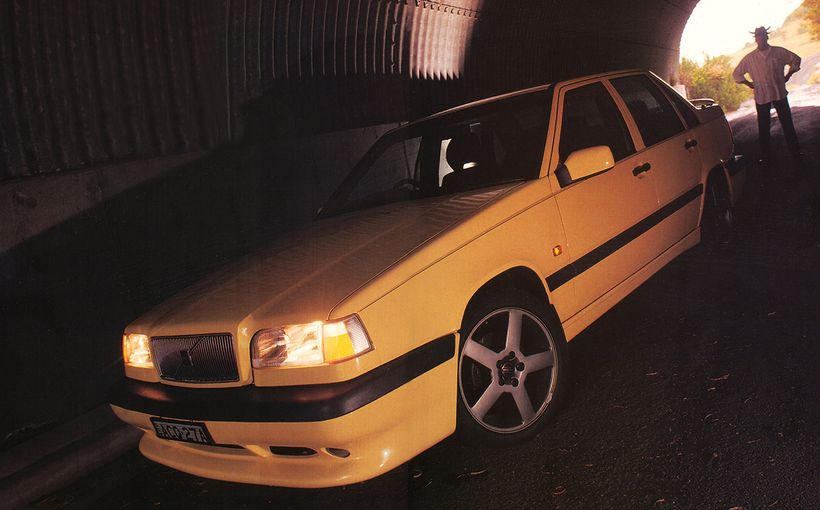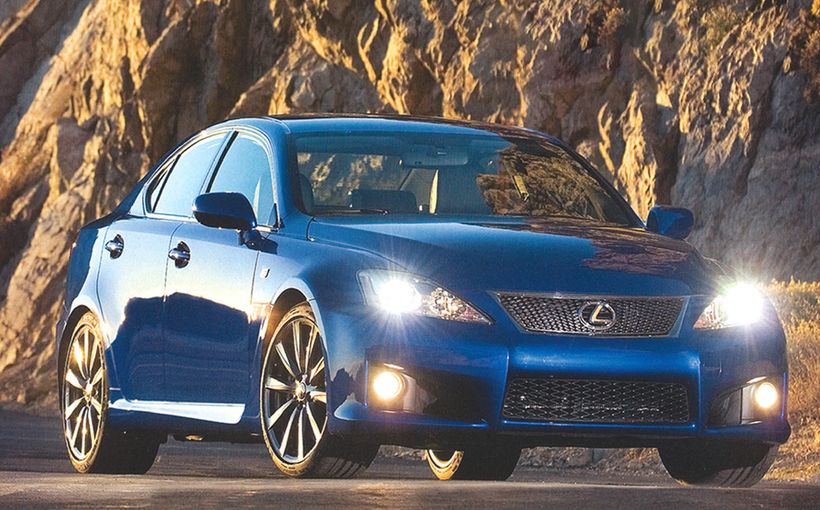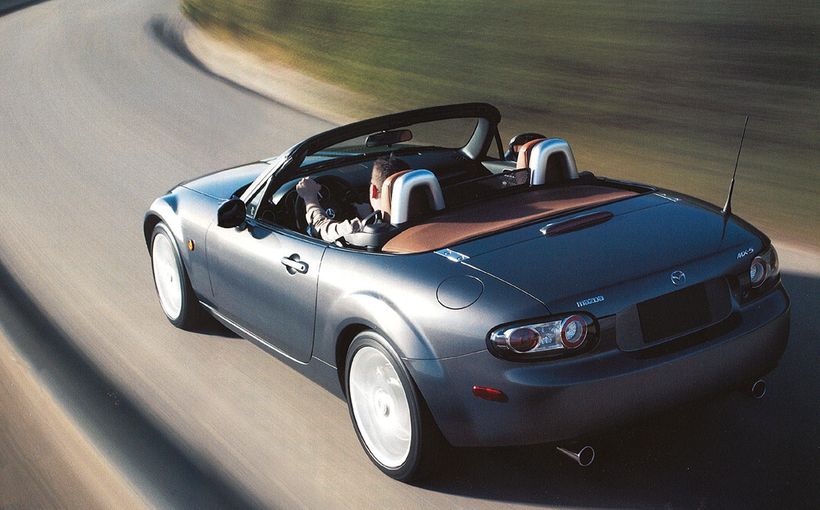TVR Griffith 500: Sexual Healing

The Griffith 500's appeal impacts, with the same pinpoint accuracy and devastating effect as a laser guided bomb, at the lower end of the spinal column. Hips shift reflexively as the message of desire explodes in the brain. And knowing that its curves conceal a 5.0 litre V8, which packs a 250 kW wallop, adds to the frisson of sensual anticipation.
This TVR possesses a purity of appearance that's magnetically attractive and candidly carnal. It's the absolute antithesis of the No Sex Please, We're British image. Blackpool on the Lancashire coast, where TVRs have always been built, is better known for Butlins than beautiful cars.

It's all a question of form, because there's very little else to see. The Griffith 500's surfaces are unsullied by commonplace car exterior furniture. There's not a bumper, doorhandle, keyhole or fuel filler cap to be seen. Without distractions, what's left for the eyes is an exquisite collection of curves.
The cockpit, too, is an assembly of artful arcs. There's an awful lot of leather. The hide is practically flawless, fitting and stitching are obviously the work of skilled craftsmen. Instruments and ventilation controls are, of course, set in panels of polished wood. The four aluminium knobs of the air-conditioning and heater system are delightfully crafted, too, though there are neither letters or symbols to hint at their respective functions. The interior door releases are also beautifully fashioned pieces of aluminium, idiosyncratically mounted on the broad transmission tunnel.
The turquoise carpet of this particular Griffith 500-perhaps chosen because of its role as an exhibit at the 1994 Sydney Motor Show- strikes a discordant note. It looks like synthetic Axminster bought cheap at a carpet warehouse closing sale. It's certainly at odds with the $141,640 price asked by TVR importers, Melbourne based Monarch Motors.

Look more closely at certain details and there's further evidence that the TVR's looks and its leather aren't matched by all other components. The instrument faces, for instance, look like photocopies of some amateur's effort at dial design.
Underbonnet- where the bored and stroked version of Rover's venerable alloy V8 sits as far back in the engine bay as possible, aiding the cause of good weight distribution - there's more disappointment.
The 5.0 litre powerplant is topped by the cast aluminium plenum chamber familiar to anyone who's seen the engine bay of a fuel injected Range Rover. But the wiring and piping that supplies the brawny engine's various needs isn't as neat and tidy as it could be. Or should be, in a car that's hand-built.

At least the stainless steel exhaust system is artful. Sweeping forward from each bank of four cylinders, a pair of huge pipes converge majestically in front of the engine. Looks great. And so does the hand-made aluminium coolant reservoir, a nicely racerish touch.
Kneeling for a peek at the Griffith 500's core structure, the substantial scale of the chassis is reminiscent of a civil engineering project. A bridge, maybe.
Perhaps careless welds are okay on bridges and probably no-one minds a bit of spatter, but this is a high-priced, handmade piece of automotive art.
But if it's no treat for the eyes, the chassis at least performs its basic function.

The Griffith transmits an immediate impression of structural integrity. The car isn't particularly heavy- it weighs 1060 kg, according to TVR, less than 10 per cent more than a Mazda MX-5 - but it feels very, very rigid.
The glass reinforced polyester resin exterior panels - fibreglass to plain folk - are obviously well screwed on. Though the bonnet sometimes shuffles slightly, there's not a hint of movement from anywhere else.
And it rides surprisingly well. Especially considering the low profile of the broad Bridgestone Expedia S-01 tyres - 215/5OZR15 fronts, 235/5OZR16 rears.
It's firm, sure, but unexpectedly absorbent, too.
But the clutch! Though hydraulic, it's heavy, heavy, heavy. And the gearbox! It's a baulky, notchy horror. There are hulking great off-road 4WDs with slicker changes than this sports car.

The brakes require a firm prod to yield good effect, but the high effort is only mildly unsettling in comparison with the fierce tramlining it often provokes. Stopping on imperfectly surfaced roads – which means the majority of Australia's bitumen - the Griffith 500's wheel jumps and jerks in the hands. The violence of the oscillations is startling at first, downright annoying thereafter.
Leaving aside this problem, little else is remarkable about the TVR's steering. It's not particularly communicative. Neither is it remarkably direct. It hovers somewhere in the region of adequacy. However, its delivery of power assistance is quite strange. Though the assisted steering is an option in Britain, it's to be standard on cars bound for Australia. What's so queer about it is its heaviness at low - as in parking - speeds. This phase is followed by a period of lightness, where there's too much assist, in turn succeeded by a sharp fall off in the level of hydraulic aid.
There is, thankfully, one source of joy to be found underfoot. What's beneath the bonnet might not be pretty, but hell, is it effective! Along with the 250 kW mentioned earlier, there's torque piled 475Nm high. Heh, heh, heh ...

Nail the accel pedal in second gear, for instance. As the tach needle sweeps past 3000 and into megadrive the nose of Griffith gains two feet of extra altitude and the back end squats and f, f, f.. fings charge from the horizon fast and gathering speed. Meanwhile, the engine's gone from a blokey burble to a ferocious bellow.
And then it's time to mash the clutch pedal into the carpet and to palm that dumb, resistant lever into third. Then relax pressure on the throttle and consider whether it might be possible for the brain to keep up with the rate of increase of speed. Next time.
And there will be a next time, no question. The thrill is simply irresistible.
The unmistakable seat-of-the-pants impression is that the Griffith 500's accelerative performance is in the supercar class.
TVR claims zero to 60 mph in 4.1 seconds, zero-100 mph in 10.2 and the standing start quarter mile in 12.2 seconds. The claims aren't an absurd distance from the truth. Britain's respected Car magazine managed 5.0 and 11.0 seconds respectively for the 60 and 100 mph sprints at the Millbrook proving ground. The first number, for example, is a match for reputable magazine test figures for the Bugatti EB110 GT.
Of course, the soft-topped TVR can't equal the top speed of the mid-engined monsters. Again measured by Car, the Griffith ran up to a genuine 253 km/h. It's more than enough speed for the majority of folks, although it's 50 km/h shy of the de facto supercar standard of 300 km/h.

Thoughts of speed are distant, however, as the Griffith brakes in obedience of another red light. Stationary, with hood down, an awful lot of heat escapes from the TVR's undersides. Some of it curls into the cockpit. On a pleasantly sunny day, with the mercury in the high 20s, the escaping warmth turns the environment from bearable to impossible. In traffic the engine coolant temperature nudges distressingly close to the red zone.
In such conditions the British car's standard-for-Australia air-con doesn't stand a chance. Or so you find, once the system's arcane controls have been mastered. But the real trouble is that the air-con only blows through two of the four cabin vents, those to the left of the car's centreline. The right-hand pair can only supply fresh air.
Erecting the roof in an attempt to capture the air-con's meagre output is, thankfully, not an odious chore. But even with the hood erect, the air-con is too feeble to have any worthwhile impact. By mid-afternoon, it's a pleasure to leave the Griffith parked.
This, too, is a problem. The car's electronic security system has a mind of its own. If not armed upon exit using the key fob switch, it will arm itself after a number of minutes. The sensitive alarm could often be triggered without any visible cause. Further craziness affects the fuel filler. It's concealed beneath the leading edge of the bootlid, and the boot can't be opened unless the ignition is live.
Like many less important systems, the Griffith 500's handling doesn't seem thoroughly thought out.

The ride is noteworthy and the tyres obviously have lots of grip, but it doesn't feel like a faithful partner for high-speed corner carving. Increasingly unsettled by road irregularities as corner speeds rise, it gives the impression it's going to be really busy at ten tenths.
As the day weers on the comparison which keeps occurring was with another maker of small numbers of hand built vehicles using mass market powerplants. In its field this company is renowned for its products' superior dynamics, gorgeous looks and impeccable finish.
Bimota is a manufacturer of some of the world's most desirable motorcycles. Like TVR they're based in a seaside town, though Rimini is on the Adriatic coast of Italy, not the Irish Sea. The beauty of a Bimota runs more than skin deep. Under the fantastic forms, craftsmanship doesn't let up. Every frame weld is perfect, the most insignificant parts are machined alloy.
Such detail is a large part of the reason they command around double the price of the mass market bikes using the same engines.
The Griffith 500 is every bit as beautiful... from a distance. But look closely, and for each small source of delight and pride there's an amateurish detail close by.
This, more even than its half-baked steering, its heavy clutch and intractable gearbox, poor ventilation and annoying security system, is what makes the British car a disenchanting experience.

Go Back in time with the Wheel Archive. Get FREE access to 5 years of Wheels archive content now!
Protect your Griffith. Call Shannons Insurance on 13 46 46 to get a quote today.









